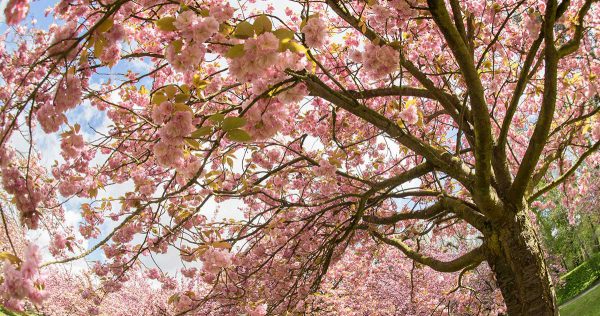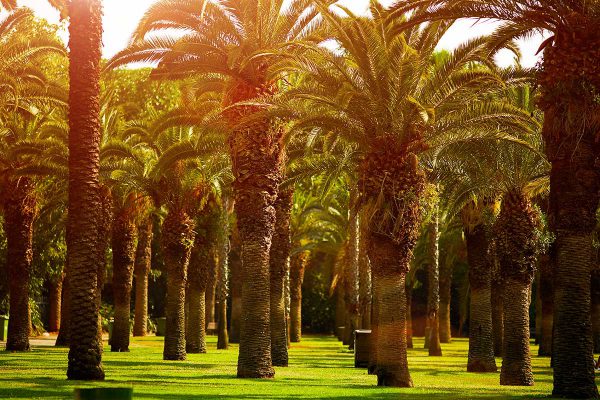
Cherry blossom orchards grow abundantly in the Golan Heights of Northern Israel.
“He will be like a tree planted near water.” (Jeremiah 17:8)
Today in Israel and around the world, we are celebrating Tu B’Shvat (the 15th of the Hebrew month of Shvat)—the Jewish holiday that recognizes a time of renewal and the stirrings of a new season by celebrating the New Year for Trees.
While this holiday is not mentioned in the Bible, it is associated with the Biblical tithe of produce.
Hillel, Yeshua, and the New Year of Trees
“I am like an olive tree flourishing in the house of God; I trust in God’s unfailing love for ever and ever.” (Psalm 52:8)
The oldest reference to this holiday is found in the Talmud (first and second century book of rabbinic decisions), where it is called Rosh HaShanah La’Ilanot (New Year of the Trees).
The rabbis placed special emphasis on trees.
For example, the Me’Am Loez (an 18th and 19th century Bible commentator) writes: “Man’s life is dependent on trees, and the tree is so important for the existence of the world that the sages established a special blessing for those who go out in [the Hebrew month of] Nisan and see blossoming fruit-producing trees. [The blessing says] ‘nothing is lacking from His world and He created good creations and good trees for the benefit of man.’”
Traditionally the holiday is referred to as Hamisha Asar B’Shvat, which means Fifteenth of Shvat. In modern Israel, it became Tu B’Shvat.

Fruits at the Mahane Yehuda market in Jerusalem.
If the idea of a New Year of Trees sounds strange, the Mishnah (rabbinic discussions that make up the Talmud) list four separate new years in Judaism.
- The first of the month of Nisan (usually coincides with April), which is the new year for counting the reign of kings and for ordering holidays;
- The first of Elul, which is considered as being the new year for animal tithes;
- The first of Tishrei (usually coincides with September), which is used as the new year for calculating Jubilee and Sabbatical years; and
- The fifteenth of Shvat, which is the beginning of the agricultural year for planting and sowing, according to Hillel, a first century sage who dominates mishnaic rabbinic thought. (Rosh Hashana:2a)
Hillel headed one of two main houses of Pharisaic practice, lived in Jerusalem, and died in AD 10. While he might have died a couple of years before 12-year-old Yeshua (Jesus) stayed behind at the Temple to discuss questions of the Law, certainly some of Hillel’s talmidim (disciples) were present.
The Talmud sages supported Hillel, making the 15th of the Hebrew month of Shvat the date for determining the beginning of the agricultural cycle for the purpose of Biblical tithes.
Biblical Tithing of Fruit
“When you enter the land and plant any kind of fruit tree, regard its fruit as forbidden. For three years you are to consider it forbidden; it must not be eaten. In the fourth year all its fruit will be holy, an offering of praise to the LORD.” (Leviticus 19:23–24)
Distinct Biblical laws refer to tithing the fruit of trees.
The term orlah (literally, uncircumcised) refers to the prohibitions mentioned in Leviticus 19:23 against the eating of fruit from trees during the first three years after they are planted.
The fourth year they are considered holy and a portion must be brought to the Temple as a tithe, according to Leviticus 19:24.
In determining when these years begin and end, Tu B’Shvat became the cut-off date for calculating the age of fruit-bearing trees.
Among Orthodox Jews, these practices are still used today, and fruit that ripens on a tree before it is three years old is restricted from use. Fruit that ripens on or after Tu B’Shvat during its third year is considered as being permitted for use.
Modern Tu B’Shvat and the Tu B’Shvat Seder
In modern-day Israel, Tu B’shvat is celebrated as a day that emphasizes ecological awareness. Many Israelis are out and about on Tu B’Shvat planting trees to renew the environment. Even schoolchildren can be seen at the national forests planting seedlings.
Today, in the classrooms and at special meals celebrated in homes and synagogues, all forms of dried fruits such as apricots and prunes, along with almonds, are enjoyed.
On this special day, we are making a point to eat the seven species of Israel that are listed in the Torah (Deuteronomy 8:8)—wheat, barley, olives, dates, grapes, figs, and pomegranates.

Dried fruits for sale in Israel.
The abundant produce of modern day Israel offers a broad choice of fruits with which to celebrate the holiday. So, in addition to the dried figs, dates, raisins, and carob eaten by previous generations, there are now oranges, avocados, bananas, pomegranates, olives, and almonds to share during Tu B’shvat seder meals.
This special meal or seder arises in the traditions of the 16th century kabbalist Rabbi Yitzhak Luria of Safed (known as ARI or Lion) who began the seder as a way of giving special recognition to the fruits and trees of the Land of Israel. Thus, he introduced the eating of fruit into the holiday.
He taught that eating ten specific fruits and drinking four cups of wine while reciting specific blessings would bring spiritual perfection to the world. The custom has been renewed in modern day Israel where it is celebrated by religious and secular alike.
The proper blessing before eating any fruit is:
Baruch Atah Adonai Elohenu Melech HaOlam boray pri ha-aitz. (Blessed are you God, King of the Universe, Who creates the fruit of the tree.)
[A few fruits, such as pineapple, have a different blessing—the last word is changed to ha-adama, meaning the land.]
Tu B’shvat Traditions
“For as the days of a tree shall be the days of my people.” (Isaiah 65:22)
Because today is associated with the harvest of fruit in Israel, Orthodox Jews are praying that God will grant beautiful etrogs (citrons) for the coming Sukkot (Feast of Tabernacles).
Various superstitions regarding fruit developed among the Sephardic (eastern oriental Jewish) communities including that of the Kurdistani Jews who placed sweet fruits like raisins in rings around trees, and would pray for an abundant fruit season.
Barren women would even plant raisins near trees or embrace them at night, while praying that they would have children.
Young girls were sometimes wedded to trees in mock ceremonies in the hope that they would soon find a groom.
In Persia, Jews lowered empty baskets down chimneys to have them return laden with fruit.
Tu B’shvat and Repairing the World
“A tithe of everything from the land, whether grain from the soil or fruit from the trees, belongs to the LORD; it is holy to the LORD.” (Leviticus 27:30)
Tu B’shvat is not only associated with the giving of the priestly tithe, but also with giving to the poor.
This special day is mentioned in the Mishnah where emphasis is on social tikkun olam [the repairing or perfecting of the world]. The issue being considered is the nature of poverty: “the poor shall never cease out of the land.” (Deuteronomy 15:11)
While there might not be a complete solution to poverty, it is possible to alleviate it through tikkun.
For this reason, the rabbis required that a portion of the fruit gathered from one’s garden be reserved for those who have no garden.
In creating this innovation, the sages were relating to the priestly concepts of tithing and terumot (heave offerings), although the Bible provides for charitable giving to the poor no specific day is named for doing this.
In fact, today Leket Israel, the National Food Bank, has volunteers across the country picking excess fruit from private gardens for the needy.
The Sayeret Tapuz project — Orange Reconnaissance Unit — include hundreds of young volunteers (many are special needs teenagers) who “rescued” this surplus produce. Sayeret is the modern Hebrew word for reconnaissance or intelligence unit in the Israeli military. (Jewish Press)

Date palms in northern Israel.
National Tikkun: The Restoration of Israel
“The days are coming,’ declares the LORD … who brought the Israelites up out of the land of the north and out of all the countries where He had banished them. ‘For I will restore them to the land I gave their ancestors.’” (Jeremiah 16:14–15)
For Zionists, the Fifteenth of Shvat is a day of national tikkun, born out of a need to repair the Land from the effects of two thousand years of exile.
It is a Jewish longing to be rid of the Diaspora character and become a part of the restoration of the Promised Land.
Tu B’shvat is therefore a day of planting of trees, turning the earth green. It is a day of strengthening one’s roots to the Land, of making the desert bloom, both the physical desert and the spiritual desert caused by the exile of the Jewish People from the Land.
For environmentalists, Tu B’Shvat is a day for ecological tikkun olam (repairing the world), in other words, a day for repairing the planet. Increasingly, over the last few decades, the holiday became a time for sounding the ecological alarm.
The Tu B’Shvat seders began to take on an environmentalist character—so much so that this holiday now has been declared Jewish Earth Day.
In so doing, Jewish environmentalist have expanded the concept of the “Land” to include the entire planet, a notion in conflict with the halakhic or rabbinic viewpoint that it relates to the Land of Israel alone.
On the other hand, the Rabbis themselves have stressed the importance of trees and their sustenance.
For example, Rabbenu Bahya, a medieval Jewish philosopher, writes: “The commentators explain that the life of man and his food is [from] a tree of the field … and it is not the way of a wise and understanding nation to needlessly destroy something so worthy, and therefore you should not cut down a tree of the field, rather you should protect it from destruction and damage, andtake benefit from it.”
“Are the trees people, that you should besiege them?” (Deuteronomy 20:19)
The rabbis also paid special consideration to what is called yishuv ha-aretz (settlement of the Land) in which special consideration is given to trees. For example, there is a rabbinic law that anyone selling land in Israel must first give preference to any neighbor who is abutting the land.
If, however, the neighbor wants to use the land for a purpose that does not contribute to yishuv ha-aretz (settlement of the Land) he loses that privilege.
For instance, if the neighbor wants to plant crops but another buyer wants to build a house, the second buyer gains preference since houses are more permanent than crops. But if the neighbor wants to plant trees, the privilege of purchasing the land goes to him.

Israeli children plant trees on Tu B’Shvat.
The power of community is described in the following story from the Talmud:
An old man was planting a tree. A young person passed by and asked, “What are you planting?”
“A carob tree,” the old man replied.
“Silly fool,” said the youth. “Don’t you know that it takes 70 years for a carob tree to bear fruit?”
“That’s okay,” said the old man. “Just as others planted for me, I plant for future generations.”
We depend on a strong community to provide a warm and nurturing environment so that the subsequent generations can grow to become rooted and grounded as trees of righteousness.
“And they will be called righteous trees, planted by the LORD to glorify Him.” (Isaiah 61:3)
















